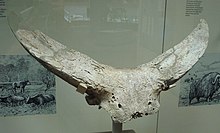|
Bubalus murrensis
Bubalus murrensis, also known as European water buffalo, is an extinct water buffalo species native to Europe during the Pleistocene epoch, possibly persisting into the Holocene. DescriptionOnly skulls have been unambiguously attributed to the species, as no complete skeletons have been found and it is difficult to distinguish postcranial bones between different bovine species. The occipital region of the skull as well as the horn cores protrude backwards. Unlike modern water buffalo, but similar to extinct Chinese Pleistocene species of Bubalus like Bubalus wansjocki, the horn cores have a triangular rather than rounded cross section, with the upper surface of the horn cores typically forming a flat plain that is continuous with the skull surface.[1] A skull found in Rhineland-Palatinate (Germany) had a width of 107 cm.[2] Distribution and habitatFossils of Bubalus murrensis are known from the late Middle Pleistocene (from around 400,000 years ago) onwards, typically during interglacial periods.[3] The European water buffalo occurred in river valleys. Remains are very rare. The majority of finds have come from along the Rhine, Elbe and Murr in Germany and the Netherlands. Isolated specimens have also been found between the Atlantic coast of France in the west and the central part of the East European Plain in the east.[1][4] It lived in muddy and swampy terrain.[5][6] Bubalus murrensis could not tolerate long-lasting episodes of frost and was therefore absent in Central Europe during the glacial periods. During the interglacial periods like the Eemian it occurred together with other species of the interglacial faunal assemblage, including the straight-tusked elephant (Palaeoloxodon antiquus), Merck's rhinoceros (Stephanorhinus kirchbergensis), fallow deer (Dama dama), aurochs (Bos primigenius) and the hippopotamus (Hippopotamus amphibius),[7][8][9] though other authors have argued that there is no unambiguous evidence for B. murrensis in Europe during the Eemian,[1] and the species is known to have disappeared from Italy by this interglacial.[10] It has been argued that the Pontic-Caspian Steppe represented a center of B. murrensis' distribution in Europe, where the species may have survived during the cold periods and spread from there to the rest of Europe during the interglacial periods.[3] Extinction and potential late survival Previously, the latest finds of Bubalus murrensis were dated to the last interglacial (known as MIS 5 or Eemian) of Central Europe, and it was therefore assumed to have become extinct sometime during the subsequent last Ice Age, similar to other representatives of the interglacial Palaeoloxodon fauna (such as the straight-tusked elephant, Merck's rhinoceros, the narrow-nosed rhinoceros (Stephanorhinus hemitoechus) and the hippopotamus). However, due to the general dearth of remains of the species, this assumption was purely speculative. In 2020, a well preserved skull was described from the East European Plain near Kolomna in Moscow Oblast, Russia, attesting to its presence in this region around 12,761 years Before Present. This is over 100,000 years after the next youngest record of the species and moves its suggested date of extinction to the Bølling–Allerød interstadial or younger, around the Pleistocene-Holocene boundary.[11][3] Some researchers believe that the species may have also persisted in southern Europe, possibly even into the Neolithic period. A relief from the Fourneau du Diable, Bourdeilles, Dordogne, France, has been interpreted by some authors as a depiction of water buffalo due to the combination of backward-facing horns, a pronounced dewlap and a characteristic dorsal line and dated to around 16,000 years Before Present.[12] Bones tentatively identified as belonging to water buffalo and dated to the earliest Neolithic have been found in the Pannonian basin. However, their identification is uncertain as postcrania of bubaline and cattle, fragmentary ones in particular, are not easily distinguishable and neither horns nor crania have been found.[13] A 2021 study suggested that traditional European water buffalo breeds such as the Italian Mediterranean buffalo and the Romanian buffalo had unique DNA sequences that could indicate that wild water buffalo from Europe were involved in breed formation, which would also point to late survival.[14] The earliest widely accepted evidence for domestic water buffalo in Europe is during the Middle Ages after 500 AD.[15] The extinction of B. murrensis, was probably caused either by the rapid cooling of the Younger Dryas, causing aridification, or by human hunting, or by a combination of both factors.[3] See alsoReferences
|
||||||||||||||||||||||||||||
